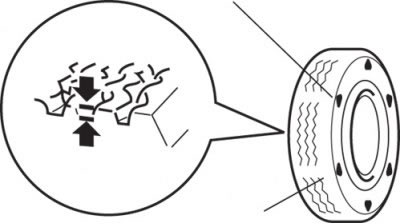Check tires for cuts, cracks or other damage. Replace tires with deep cuts or cracks. Periodically inspect all tires and remove metal objects and stones stuck in them. Operating tires with a worn tread is very dangerous due to the high likelihood of skidding or hydroplaning (tires floating above the road surface flooded with water). Tires must have a tread height of more than 1.6mm to meet the minimum performance requirements.

Pic. 2.14. Location of tire tread wear indicators
If the tires are equipped with wear indicators (arranged in a circle), then as the tire wears, they become visible at six points on its surface, indicating that it is time to replace the tires with new ones (pic. 2.14).
If there is uneven tire wear, the cause must be found and corrected. The types and causes of tire tread wear are given in Table. 2.1.
Table 2.1. Types and causes of tire tread wear

Tire leaks can be identified with soap suds.
Carefully inspect the inside side of each tire for traces of brake fluid.
Normal tire pressure prolongs its life, so it should be checked regularly. Check pressure only on cold tires.
Tire wear may vary depending on vehicle condition, road conditions and individual driving habits. To ensure more even tire wear and prolong tire life, it is recommended to rotate the wheels as soon as there is uneven wear or a difference between front and rear tire wear.
Note. Do not install wheels of different types of tires and rims on the vehicle. This can adversely affect traffic safety.
